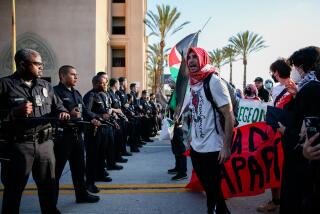It was aptly named for the Roman...
- Share via
It was aptly named for the Roman goddess of fruit, and from its fertile soil sprang not just citrus and other rich crops but a widely heralded university, the world’s largest county fair and a burgeoning middle-class population.
Yet, just 60 years after cereal king W.K. Kellogg brought the first of his champion Arabian horses to graze its verdant fields, Pomona was labeled the second most stressful city in the nation.
Early settlers named the community Spadra, after Spadra Bluffs, Ark., the hometown of the Butterfield stage station operator, William Rubottom. Unfortunately for the town’s future, the Southern Pacific Railroad made Colton the terminus of the line instead of Spadra.
Even though the decision spelled the end of the line for Spadra, it was just the beginning for Pomona. In 1888, when the town incorporated and nurseryman Solomon Gates won a town lot as a prize for suggesting the community’s new name, its population soared from 300 to 3,000. Over the next century, it would become Los Angeles County’s fourth-largest city.
In the 1920s, Pomona basked in the golden glow of its groves and was renowned as the “Queen of the Citrus.” But even when the citrus industry was prominent, nothing shaped the community more than the county fair.
The fair began in 1922, about three decades before the Pomona Raceway, the first police-sponsored drag strip, made its debut. The big Red Cars ran the city folk out to Pomona’s fairgrounds, where judges exalted perfect pomegranate jelly and medicine men pitched mineral water and constipation cures.
A few years later, after Kellogg put cornflakes on the market and started to change the breakfast habits of the nation, he bought a fertile valley where he built a Spanish-style villa atop a hill that would become the last traffic jam point between Los Angeles and the Inland Empire.
In 1932, Kellogg donated his ranch to what is now Cal Poly Pomona. Many of the horses at the W.K. Kellogg Arabian Horse Center are descendants of the original stock.
The town began to languish in the late 1960s as small businesses died or fled to new malls. By the early 1970s, Pomona had lost more than 50% of its retail stores and businesses, and nearly 1,000 homes were abandoned and boarded up.
The city embarked on an ambitious revitalization campaign, beginning in the late 1970s with the Phillips Ranch housing development, whose construction signaled a major turning point for Pomona. Today, a budding artists colony on Second Street downtown features galleries, antique shops and vintage clothing stores.
Pomona: Inside Out
STRESS TEST: In 1985, after a study by Zero Population Growth Inc. labeled image-conscious Pomona the second-most stressful city in the nation, city employees designed a T-shirt featuring a logo resembling the city seal, with Sylvester Stallone’s Rambo character standing in for the Roman goddess of fruit, his machine gun replacing the horn of plenty and guarded by a Doberman pinscher. City workers even mailed some T-shirts to Miami, which topped the list.
UPSCALE: Separated from the rest of the city by hills, economic status and the Corona Freeway, the Phillips Ranch community of more than 4,000 homes was named for one of Pomona’s founders, Louis Phillips. In 1866, after two merchants foreclosed on Ricardo Vejar’s 40,000-acre rancho, Phillips bought 12,000 acres and later built the city’s first three-story brick mansion on Pomona Boulevard.
SECRET LIFE: One of the Pomona Valley’s little-known treasures is Ganesha Hills, a bucolic community of 500 homes in the northwestern section of the city. Developed in the 1920s, the neighborhood of bungalows and mansions, set amid chaparral and oaks, was named for the elephant-headed Hindu god of good fortune.
BLAZING MISTAKE: A Detroit newspaper singled out Pomona as the nation’s No. 1 hot spot for arsonists, in a report based on FBI statistics that received wide circulation. It said arsonists set 757 fires in 1988 in Pomona, a 125% increase from 1987 for the city of 120,620. After the Pomona Fire Department did some furious number crunching, it found that the FBI figures were for all fires, not just those that were deliberately set. Though local officials gave a sigh of relief, the damage was done.
More to Read
Sign up for Essential California
The most important California stories and recommendations in your inbox every morning.
You may occasionally receive promotional content from the Los Angeles Times.













